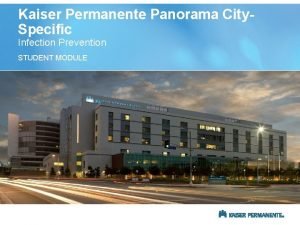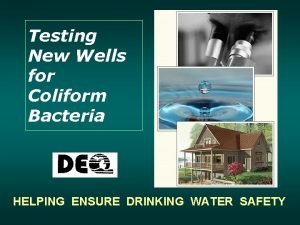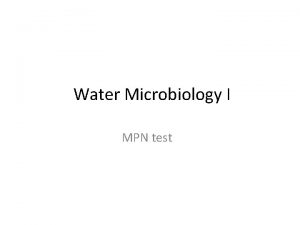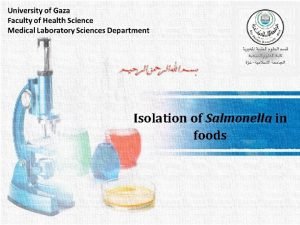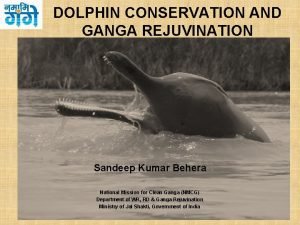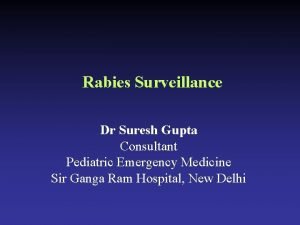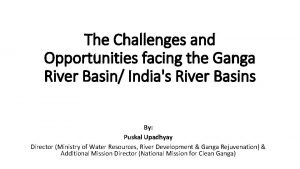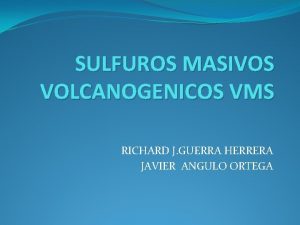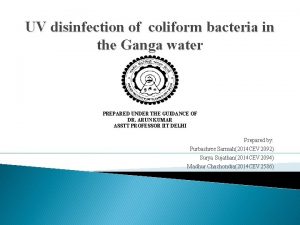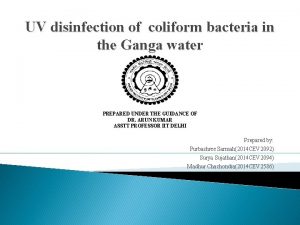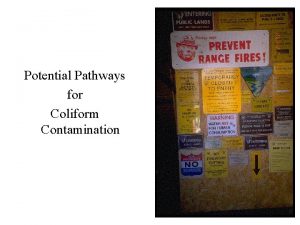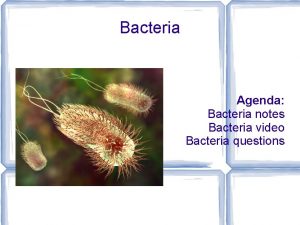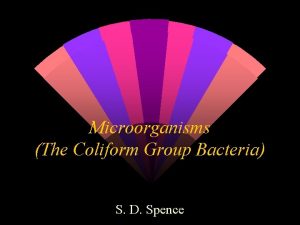UV disinfection of coliform bacteria in the Ganga

UV disinfection of coliform bacteria in the Ganga water PREPARED UNDER THE GUIDANCE OF DR. ARUN KUMAR ASSTT PROFESSOR IIT DELHI Prepared by: Purbashree Sarmah(2014 CEV 2092) Surya Sujathan(2014 CEV 2094) Madhur Chachondia(2014 CEV 2586)

INTRODUCTION � Ganga water facing water quality deterioration: ◦ River’s importance in Indian culture ◦ dense population residing at its banks ◦ faces several forced and unforced human activities � In the sites it was observed that the TVC values were relatively higher in holy places (Sood et al. , 2008) � In this review paper, effectiveness of Ultraviolet irradiation on coliform bacteria inactivation in the Ganga water is reviewed.

METHOD USED: UV Disinfection Method � � � Germicidal action mainly due to UV-C light on microorganisms. Consists of UV reactors that efficiently delivers the required dose for microbial inactivation. The microbial response is given by the 1 st order kinetic Equation as shown below: Where N 0 = Concentration of infectious microorganisms before exposure to UV light N = Concentration of infectious microorganisms after exposure to UV light � UV reactors made of open/closed channel vessels containing: ◦ UV lamps ◦ lamp sleeves ◦ UV sensors ◦ temperature sensors Figure 1: Example of UV Disinfection Equipment (USEPA, 2006, UV Disinfection Guidance Manual; Severn Trent Services)

PRESENT STATUS Table 1: Final table for different parameters affecting UV disinfection from different journals Parameters Various option from different journals UV Light Generation UV-LEDs, and Propagation high-pressure mercury vapor lamp with side glowing optical fiber, LP, MP, PUV with pulsed xenon source UV Dose-Response UV-LEDs with 10. 8, 13. 8, 56. 9 m. J/cm 2, High -pressure mercury vapor lamp with 17. 2 m. W/cm 2, PUV with 3 m. J/cm 2 Wavelength 265 nm, 280 nm, 310 nm, 254 nm, 200 nm, 270 nm Turbidity 14 NTU, 0. 67 NTU, 10 NTU, 2. 2 NTU, 6. 5 NTU, 10. 2 NTU Best option(log reduction up to 4) PUV with pulsed xenon source with side glowing optical fibre Challenge Pre treatment PUV with 3 m. J/cm 2 Costly Sedimentation, Filtration 254 nm Difficult to maintain Sedimentation, Filtration 0 -10 NTU Water should be filtered Sedimentation, until getting the required Filtration standard Costly than other Sedimentation, methods. Maintenance Filtration is difficult Our sample where E coli was present in maximum quantity of about 27 CFU if we apply all the best options we may get up to 4 log reduction.

POSSIBILITY OF IMPROVEMENT � To achieve better disinfection following may can be adopted: ◦ Optical fibre can be used to ensure uniform distribution within the UV reactor. ◦ Pre treatment such as coagulation, sedimentation and filtration can be adopted to reduce high turbidity and organic matter present in Ganga water. ◦ UV reactors can be improved to make process more economical so as to improve its popularity compared to chlorine disinfection.

FUTURE SCOPE � Ample quantitative information is needed to study the effect of microorganism-related factors like : ◦ Different environmental species encountered in water ◦ DNA repair mechanism ◦ Differences in spectral sensitivity in various micro-organisms � Further research is required in accurate analysis of water flows and UV intensity over UV reactors, using CFD so as to achieve simple, reliable and cheap in situ process control systems. � Further research can be done on the optimum use of optical fibre to achieve more economy.

CONCLUSION ► UV disinfection is best method for disinfection as it requires no chemical consumption thus: o o o ► ► Saves large scale storage space Transportation and managing cost Safety hazards related issues High removal of 99. 99% can be attained if used under optimum operational conditions. Does not give toxic byproducts such as trihalomethanes. But it is not very cost effective compared to chlorine disinfection. It cannot give any residual because of which it is more popular only for POU systems.

REFERENCES � Anchal. Sood, Kamal Deep Singh, Piyush. Pandey, Shivesh Sharma, 2008, “Assessment of bacterial indicators and physicochemical parameters to investigate pollution status of Gangetic river system of Uttarakhand (India)”, Ecological Indicators 8 ( 2008 ) 709 – 717 � Andreza B. Silva, Nelson M. Lima Filho, Maria A. P. F. Palha, Sandra M. Sarmento, 2012, “Kinetics of water disinfection using UV-C radiation”, Fuel 110 (2013) 114– 123 � Brahmi. Mounaouer, Hassen. Abdennaceur; “Ultraviolet Radiation for Microorganism Inactivation in Wastewater”, 2011, Journal of Environmental Protection, 2012, 3, 194 -202. � Dunn, J. , Ott, W. , Clark, W. , 1995. Pulsed-light treatment of food and packaging. Food Technol. 49, 95– 98. � Gang Lu, Chaolin Li *, Yinggang. Zheng, Qian Zhang, Juan Peng, Ming Fu, 2008, “A novel fiber optical device for ultraviolet disinfection of water”, Environmental Science and Engineering Research Center, Shenzhen Graduate School, Harbin Institute of Technology, Shenzhen 518055, PR China. � Gates, F. L. , 1930. A study of the bactericidal action of ultraviolet light, III: the absorption of ultraviolet light by bacteria. J. Gen. Physiol. 13, 31– 42. � Halliday, D. , R. Resnick. 1978. Physics. John Wiley & Sons, New York. � Hoyer, O. , 2004. Water disinfection with UV radiation—requirements and realization. In: Proceedings of the European Conference UV Karlsruhe, UV radiation. Effects and Technologies, September 22– 24, 2003, Karlsruhe � Kumiko Oguma, Ryo Kita, Hiroshi Sakai, Michio. Murakami, Satoshi Takizawa, 2013, “Application of UV light emitting diodes to batch and flow-through water disinfection systems” Desalination 328 (2013) 24– 30. � Linden, K. G. , Shin, G. , Sobsey, M. D. , 2001. Comparative effectiveness of UV wavelengths for the inactivation of Cryptosporidium parvum oocysts in water. Water Sci. Technol. 43, 171– 174.

REFERENCES contd. . � Meulemans, C. C. E. 1986. The basic principles of UV-sterilization of water. In: Ozone +Ultraviolet Water Treatment, Aquatec Amsterdam, Paris: International Ozone. Association. � Miller, R. , Jeffrey, W. , Mitchell, D. , Elasri, M. , 1999. Bacterial responses to ultraviolet light. Am. Soc. Microbi ol. 65, 535– 541. � Oguma, Katayama, H. , Ohgaki, S. , 2002. Photoreactivation of Escherichia coli after low- or medium-pressure UV disinfection determined by an endonuclease sensitive site assay. Appl. Environ. Microbiol. 68, 6029– 6035. � Parker, J. A. , and J. L. Darby. 1995. Particle-associated coliform in secondary effluents: Shielding from ultraviolet light disinfection. Water Environment Research 67: 1065– 1075. � Raymond E. Cantwell, Ron Hofmann, “Inactivation of indigenous coliform bacteria in unfiltered surface water by ultraviolet light”, 2008, Elsevier Ltd. WATER RESEARCH 42 (2008) 2729 – 2735. � Robert G. Qualls, Michael P. Flynn, J. Donald Johnson , 2013, “ The role of suspended particle in ultraviolet disinfection”, Journal (Water Pollution Control Federation), Vol. 55, No. 10 (Oct. , 1983), pp. 1280 -1285 � Ruby Pandey, Divya. Raghuvanshi, D. N Shukla, 2014, “Assessment of Physico-Chemical Parameters of River Ganga at Allahabad With Respect To WQI”, International Journal of Innovative Research in Science, Engineering and Technology (An ISO 3297: 2007 Certified Organization) Vol. 3, Issue 9, September 2014 � T. Wang, S. J. Mac. Gregor , J. G. Anderson, G. A. Woolsey, 2005, “Pulsed ultra-violet inactivation spectrum of Escherichia coli”, The Robertson Trust Laboratory for Electronic Sterilisation Technologies, University of Strathclyde, Royal College, 204 George Street, Glasgow G 1 1 XW, UK � USEPA, 2006, “Ultraviolet Disinfection Guidance Manual for the final long term 2 enhanced surface water treatment rule”, Office of Water (4601), EPA 815 -R-06 -007 � W. A. M. Hijnen, E. F. Beerendonk, G. J. Medema, 2005, “Inactivation credit of UV radiation for viruses, bacteria and protozoan (oo)cysts in water: A review”, Kiwa Water Research Ltd. , P. O. Box 1072, 3430 BB Nieuwegein, The Netherlands.
- Slides: 9
